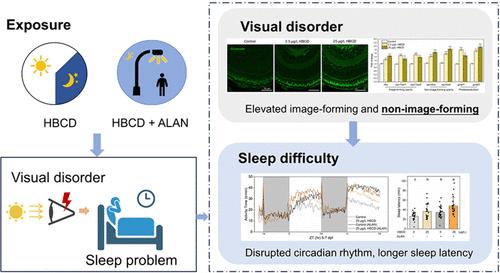溴化阻燃剂六溴环十二烷和夜间人造光协同导致斑马鱼幼体视觉障碍和睡眠困难
IF 10.8
1区 环境科学与生态学
Q1 ENGINEERING, ENVIRONMENTAL
引用次数: 0
摘要
睡眠困难是一个普遍存在的健康问题,光污染和化学污染等因素加剧了这一问题。夜间人造光(ALAN)会扰乱自然睡眠-觉醒周期,而化学污染物则会损害与睡眠相关的过程。ALAN的普遍存在增加了共同暴露的健康风险,但却没有引起足够的重视。与此同时,视觉输入对睡眠调节也很重要,尤其是以黑素为中心的非成像昼夜节律视觉系统。本研究评估了暴露于环境相关浓度(2.5 和 25 μg/L)的阻燃剂六溴环十二烷(HBCDs)以及 HBCD 和 ALAN 共处理的斑马鱼幼体的光感知能力和睡眠表现。与对照组(26.04 分钟)相比,在 25 μg/L 浓度下,六溴环十二烷诱导的睡眠潜伏期延长了 34.59 分钟(p < 0.01)。在与低浓度 ALAN(10 lx)同时暴露的情况下,睡眠潜伏期延长至 48.04 分钟。在上调与爪蟾相关的黑色素视蛋白基因和下调褪黑激素合成基因aanat2方面也观察到类似的协同效应,这表明黑色素视蛋白-aanat2-睡眠视网膜-大脑通路。图像形成蛋白(opn1sw1和opn1sw2)也被六溴环十二烷激活了1.29-1.53倍(p <0.05),同时视网膜谷氨酸升高,但没有协同作用。综上所述,我们发现六溴环十二烷和 ALAN 共同暴露会对斑马鱼幼体的非成像视觉系统产生协同效应,并导致睡眠困难。本文章由计算机程序翻译,如有差异,请以英文原文为准。

Brominated Flame Retardant HBCD and Artificial Light at Night Synergically Caused Visual Disorder and Sleep Difficulty in Zebrafish Larvae
Sleep difficulty is a widespread health concern exacerbated by factors such as light and chemical pollution. Artificial light at night (ALAN) can disrupt natural sleep–wake cycles, whereas chemical pollutants can impair sleep-related processes. The prevalence of ALAN increases the health risk of coexposure, yet it has not gained sufficient attention. Meanwhile, visual inputs are important for sleep regulation, especially the non-image-forming circadian visual system centered around melanopsin. This study evaluated the light perception ability and sleep performance of zebrafish larvae exposed to flame retardant hexabromocyclododecanes (HBCDs) at environmentally relevant concentrations (2.5 and 25 μg/L) and to cotreatment of HBCD and ALAN. HBCD induced a longer sleep latency of 34.59 min under 25 μg/L (p < 0.01) versus control (26.04 min). The situation was intensified by coexposure with low-level ALAN (10 lx) to 48.04 min. Similar synergic effects were observed for upregulations of Xenopus-related melanopsin genes and downregulations of the melatonin synthesis gene aanat2, suggesting a melanopsin–aanat2–sleep retina–brain pathway. Image-forming opsins (opn1sw1 and opn1sw2) were also activated by HBCD to 1.29–1.53-fold (p < 0.05), together with elevated retina glutamate, but without synergic effects. Collectively, we found that HBCD and ALAN coexposure caused synergic effects on the non-image-forming visual system and caused sleep difficulty in zebrafish larvae.
求助全文
通过发布文献求助,成功后即可免费获取论文全文。
去求助
来源期刊

环境科学与技术
环境科学-工程:环境
CiteScore
17.50
自引率
9.60%
发文量
12359
审稿时长
2.8 months
期刊介绍:
Environmental Science & Technology (ES&T) is a co-sponsored academic and technical magazine by the Hubei Provincial Environmental Protection Bureau and the Hubei Provincial Academy of Environmental Sciences.
Environmental Science & Technology (ES&T) holds the status of Chinese core journals, scientific papers source journals of China, Chinese Science Citation Database source journals, and Chinese Academic Journal Comprehensive Evaluation Database source journals. This publication focuses on the academic field of environmental protection, featuring articles related to environmental protection and technical advancements.
 求助内容:
求助内容: 应助结果提醒方式:
应助结果提醒方式:


